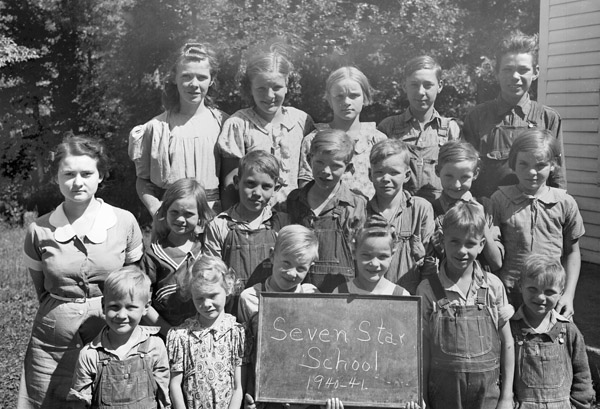Seven Star City by Gloria Crosby from Back to Barry
Southward from where Thomas Hollow waters flow into Mike's Creek, some 1 ½ or 2 miles, another stream from the east makes its way into Mike's Creek or what is known as the Bob Michael Farm. This small valley or hollow through which this stream of water flows is called the "Seven Star Spring Hollow." About 3 1/2 miles east, up to this hollow, a big spring flows out over a large ledge of flat rock. There are seven holes or small basins, resembling stars in this ledge of rock, hence the name "Seven Star Spring."
David Norman was said to have discovered this spring. There is a marvelous and fabulous true story about this "Seven Star Spring" and the immediate surroundings. The first man to discover healing powers in these waters was a Mr. Hodo, who was camping by the spring. He began drinking this water and bathing his sore legs two or three times each day. He soon noticed they were slowly healing, so he kept this up for a short while, and was said to be completely cured. Others soon became interested in this healing spring. Another man by the name of Shultz heard of the spring. He had TB and only weighed 90 pounds. He drank the water for 2 years then left for Kansas in a covered wagon seemingly well, weighing 180 pounds.
News of the healing water traveled fast and folks rushed here from all parts of the country. Buildings went up in the valley, on the hillsides and on top of hills. This little resort town mushroomed in a short time and was said to have reached 2000 population. Homer Biggins burned and manufactured brick for building purposes. Pine lumber was hauled from Neosho, Missouri to build houses. Marshal Correly and Dale Fly set up a large sawmill to saw native timber into lumber for framing. For power they used a 16 foot boiler. They had a large circle saw, 68 inches in diameter. Three shafts were dug on a hillside, 10 or 12 feet deep where a fine quality of red clay was found. This was mixed with linseed oil and made an excellent paint that was used extensively. Lime was also manufactured in Seven Star Hollow. Many streets were laid out where ledges of rock were encountered. Fills were made so the streets could continue. The same year, 1881, Eli Albert put up a livery stable. John Ware had a blacksmith shop. Folks came from all around for the Fourth of July celebration. About every tree in the valley had a horse tied to it.
By August 1881, 300 lots in the town had been purchased. Eli Albert erected a 35 room hotel east of the spring, one floor was used for dancing. Judge Horine built a bath house west of the spring. A saloon called The Boss went up. Stores and other businesses included Chew's Store, Fisher and Boswell Store, Fly's Feed Store and Stephenson's Hall in which court was held, and also public gatherings. There was a picture gallery, Mose Hodge Hotel, and Campbell's Hall in which was the post office and printing office. West of main street was Lanum's Furniture Store, Dink Jeffries' Drugstore, Loring Hotel, Adamson's Livery Stable, Smith Hotel with 40 rooms (burned down later) and Mose Hodge Butcher Shop.
"Snapping Wilson" who lived with his wife next to the Loring Hotel was the leading musician for dances and social affairs. Wilson left one night and wasn't found for several days. A friend found him hanging from a cliff up a small hollow, now called "Wilson's Hollow," at times called "Dead Man's Hollow." The town was said to have been incorporated December 1881 with 5 trustees. The population was estimated at 1,500.
A large sign arched over the spring stating the medical properties of the water. In many crevices of the bluffs along Star Hollow and Mike's Creek can be found Epsom Salts, used by many old timers. There was some prospecting done near Star Hollow. Everyone was excited when mineral was found in one shaft, but it was soon learned that mineral from Granby, Missouri had been thrown in the shaft.
Traveling shows often stopped to provide entertainment. Once a famous shirt-tail foot race was run. Seven Star City flourished to the point it was said to be the best town in Barry County, except for Cassville. In the bluff opposite the spring was a large cave called "Bear Cave." Wallows in the dirt floor were said to be where bears slept. In Seven Star City Buster Carruthers was postmaster, Billie Davis, town marshal, Jim Stalcup, a butcher, Bill Smith, night watchman, Dr. McDonald, town doctor, Babe Roseberry, restaurant operator, David Norman, liquor store, Jim Jacoby, gambling, Bob Michael, dance hall, Howard (Judge) Brown, owned two hotels, one on top of the hill, and one directly over the spring with 72 rooms and a large bathing pool in the basement. East and West the town was about one mile across.
On July 9, 1889 sudden destruction came. About 10:00 a.m. a small cloud appeared in the sky and it began to rain. Soon the rain pounded down with fury. By 4:00 p.m. all businesses and homes in the town had been damaged or destroyed by flood waters. Nobody drowned. The houses or businesses left standing were moved away. Everyone chose to leave instead of rebuild. Seven Star City is now a bed of gravel, but the spring with the seven basins resembling stars remains as a reminder of a glorious past. |

